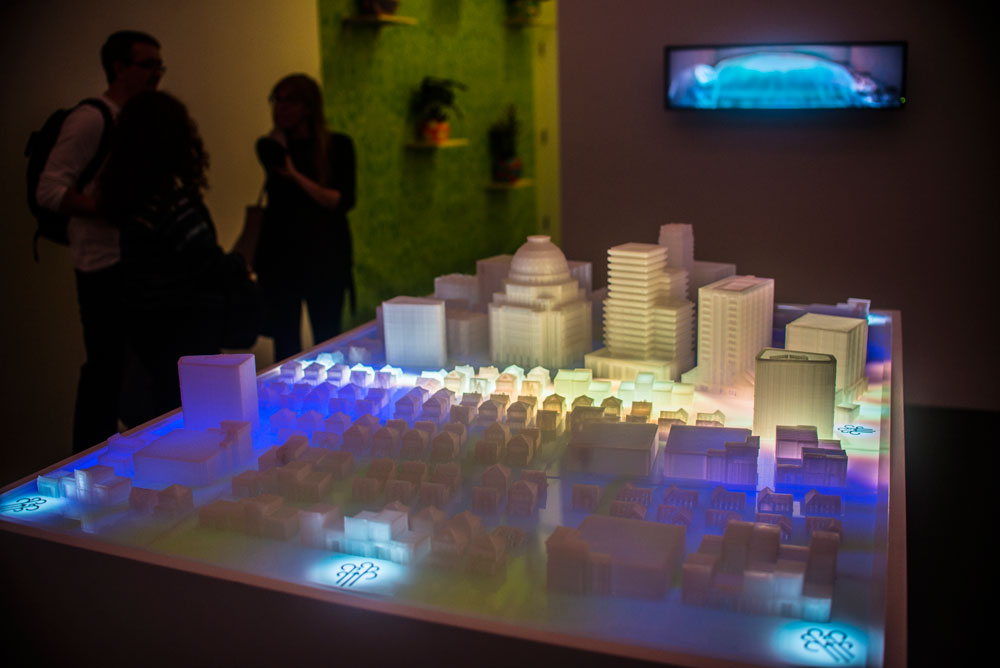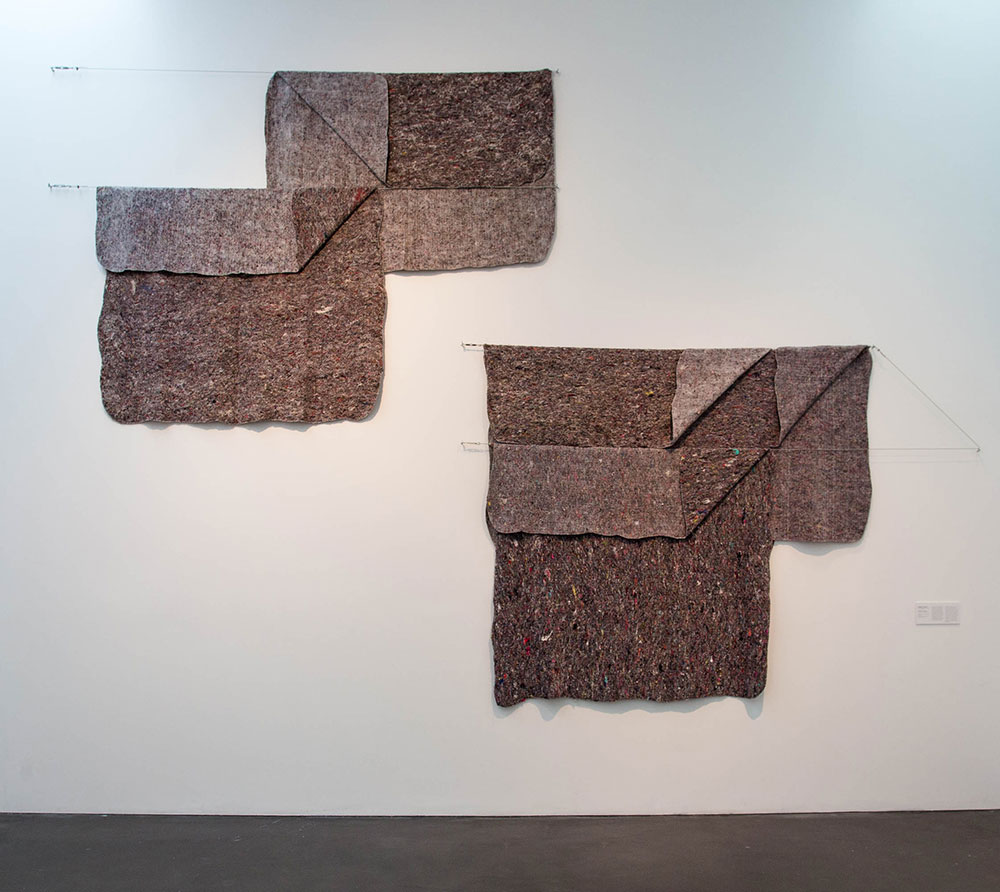Exhibition labels – those little placards on the walls beside the thing part of the art – are no longer optional to conscientious looking. In the imagined past, we might have taken in a landscape and breathed, “Isn’t that lovely? Just look at those brushstrokes!” But the priorities of contemporary art have foreclosed on this option. We might even go so far as to define contemporary art as that species of aesthetic work (as opposed to modern, folk, etc.) for which the label is as important as the specimen. Otherwise we risk missing the conceptual forest for the material trees.
Since the 1990s one of the more dominant strains of new work has been a technologically-oriented conceptualism that — if it doesn’t dispose of humanity altogether: the bodily, the gestural, the domestic – finds its importance only in the way those bodies have extended themselves through technology, a technology well-removed from the state of nature, the nuts-and-bolts of existence, anything a patron could begin to brim sentimental over.
Such art is often interested in incorporating materials not typically found in an art gallery, at least not 25 years ago: open source models, industrial units, server platforms, new plastics. At its best, such work lays bare the hidden cables that stitch our new world together, make us suddenly hyper-conscious of the pattern of which we form a part, an invisible part. Exhibition labels are doubly important in such work: without the ideas behind the work, which almost always require spelling-out, we have nothing.
This is doubly true at Now? Now!, the Denver Museum of Contemporary Art’s contribution to the Biennial of the Americas. As the aim behind the enterprise is cultural exchange, we’re hesitant to even approach the stuff on display before we know where its maker is from, anxious to insure that we don’t casually misread another culture’s symbols or its myths.
No work can be Contemporary with a capital C unless it is, at least in part, conceptual, and yet the chances are it’s constructed from tangible materials, and those materials will inevitably have their own story to tell. This tension – roughly, between the actual and the ineffable – keeps all of the work in this latest show unusually vibrant, though some pieces vibrate at higher frequencies than others.

Stepping into the room on the second floor solely devoted to Chris Coleman and Laleh Mehran’s Unclaimed, you encounter a scale model of a city on a waist-high plinth. Gradually, you become aware of a crinkling sound above you: a ceiling made of plastic, rippling when you breathe. This is due to the tiny fans hooked up below the ceiling, pointing up. They’re rigged to trigger a ripple when you speak or direct any air across the model city. These movements also light that city from beneath.
As the placard explains, the model city in Unclaimed is intended to direct the viewer’s attention to the air above it, the layer of troposphere (incorrectly identified on the label as “the stratosphere,” a higher elevation than the one in question) between the roofs of the buildings and the air space controlled by federal aviation. This, we’re told, is the last morsel of uncontrolled real estate in the United States, the last unclaimed space.
Like most objects generated from a 3-D printer, the scale model has a translucent, prenatal quality. It’s deliberately no-place: a row of toy houses, a couple of big-box stores, skyscrapers, and a basilica at its center. There are no trees, no dogs or people. Though the artists may or may not have intended this, their model evokes a world in which all life, except the viewer’s own godly breath, is absent or extinguished, leaving only an empty city.
It is smart, engagé, and forbiddingly austere. There is a death-like whiteness to the rubbery city, and an eeriness to the crinkle above, not entirely mitigated by the extra-terrestrial lights. One ingests the idea – that unclaimed space is a commons, aswirl with molecules we’ll all be breathing – but one does not linger over it. It would be like lingering inside an empty morgue.
Like Unclaimed, Sterling Crispin’s N.A.N.O family of sculptures reads as much like a science project as it does an object of art: four five-foot server racks frame little stock trading screens. The screens occupy the upper half of the racks, and emergency survival material (water, a nanofilter, dried food) comprise the lower half. Nanotech (where N.A.N.O gets its name) is one of the four respective industries each machine represents an investment in (an actual clutch of shares); the others are B.I.O., I.N.F.O., and C.O.G.N.O. – the four new gods of the future. All of these bits and pieces are secured to the tall racks with zip ties. In a nod to Shinto shrines, all four servers are framed with black Plexiglas edgings, like three-dimensional Rorschach blotches. It personalizes them a little, giving them more human dimensions, like toy Japanese robots from the 1980s.
Crispin’s server assemblages touch nicely on the familiar places our fear and our cynicism lie. They also compose a challenge: Our whole society is built on silicon, they seem to say, so you can be cynical about that all you like, but should it fail, should it collapse, you’ll need this water and this food. There are a lot of ideas in the pieces. It is art that has checked every box, even gesturing toward the aesthetic. Contempt and trepidation are emotions it seeks to provoke, but because it works so unsubtly to do so, and so self-consciously, I wasn’t lured into them. I felt instead a cool admiration for the artist’s ambition.
Warmer – perhaps because it touches more immediately on the purely human – is the Brazilian artist Marcello Cicade’s Geometry of Collapse. Don’t let the pretentious name fool you: this is the real thing, a piece you might walk straight past with a roll of your eyes in one sort of mood, but one that, in another sort of mood, absorbs as much of your time as you’re willing to give it, or that you can’t help but give it.

Five gray blankets hang suspended from a wire high on the wall, roughly gathered into two folded squares, corners turned back like hotel linen. There’s tension here between the desire of the viewer’s mind to call the shape a square, and the blankets’ uneven hems. There’s also tension between the setting, a reasonably prestigious museum filled with reasonably well-dressed patrons, and the blankets themselves: they are recycled industrial-fiber blankets of the kind that cities like Denver and Sāo Paulo distribute free to the homeless. This is stunt tension, of course, but it works.
These are new blankets and they smell new, a world away from how they would smell in use. They couldn’t be more conspicuous here, even in a crowded room, but they work as a sort of camouflage on the streets, hiding their uniform users, blending them together, concealing them.
They move a little in the air, brushing lightly back and forth against the wall. This calls to mind the movement of a body inside them. And it does so in a way that makes itself indispensable as an object. I enjoyed thinking about Unclaimed and N.A.N.O., but I don’t feel the need to look at them again. I get the ideas. Geometry of Collapse isn’t like that.
Up close, metallic fibers glisten; small leaves are caught in the weave and press; pinkish gray fibers at a distance differentiate into every possible color up close: dirty peach, turquoise, infected mauve. You could look and find new things for hours. As a consequence, Cicade’s blankets are not merely a political statement, they are a readymade Jackson Pollock. They do not, like Jeff Koons’ Hoovers in vitrines, blandly lob a spitball at the middle class, winking all the while. They indict everyone in the gallery space at the same time that they captivate as objects. •
Lead image: Sterling Crispin (b. 1985, Maui, HI; lives and works in Topanga, CA), N.A.N.O., B.I.O., I.N.F.O. and C.O.N.G.O., 2015. Aluminum server rack, Ethernet cables, zipties, LCD screen, survival equipment, water, dehydrated food, and mixed media. Courtesy the artist and Evan Semón.




